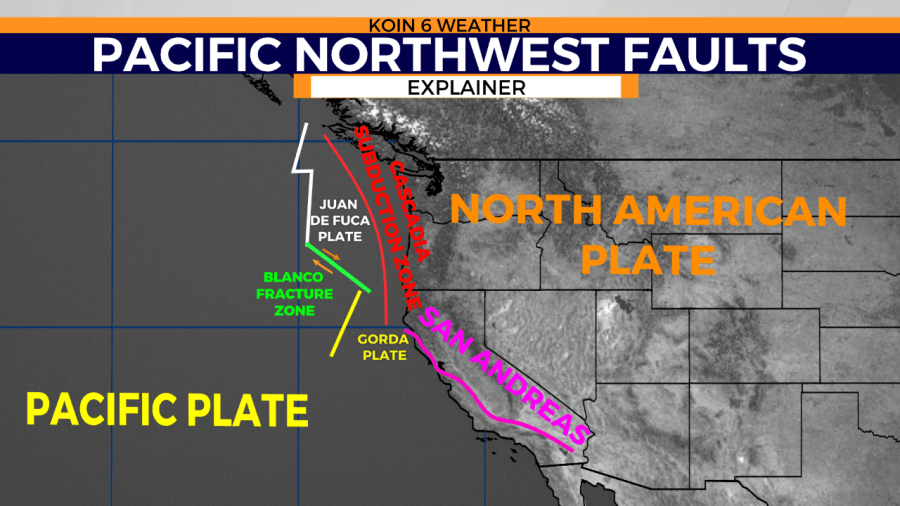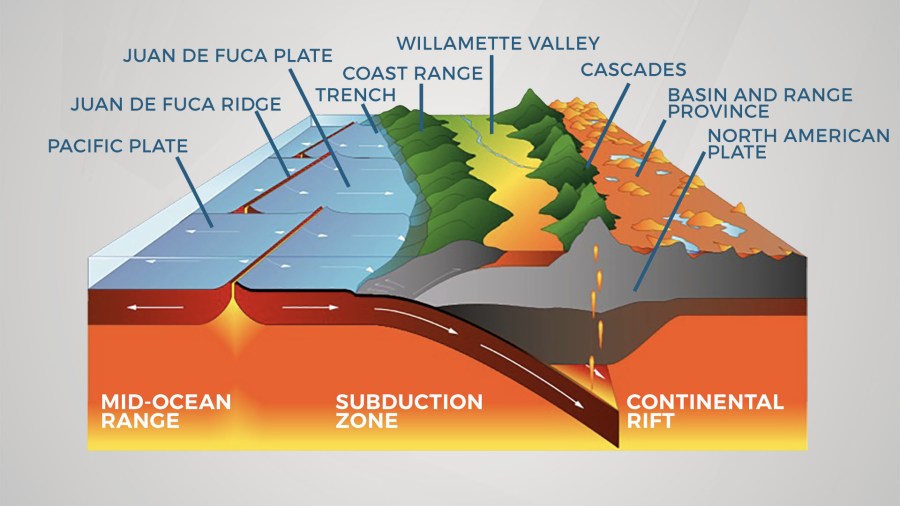PORTLAND, Ore. (KOIN) — Beneath our feet, the ground is moving. Of course not very fast, but, geologists say the North American Plate is moving about an inch a year.
Not only are we slowly moving, but we are also actually rotating in a clockwise movement because of the ongoing exercise of the earth’s crust, which is known as the tectonic plates.

There is no doubt that you’ve heard of the Cascadia Subduction Zone, but there is a lot going on around us that can be the source or location of nearby earthquakes, including, but not limited to the North American Plate, the Pacific Plate, Juan de Fuca Plate, the Gorda Plate, the Blanco Fracture Zone and the San Andreas Fault.
What exactly is the cause of some of the earthquake commotion here in Pacific Northwest? The North American plate is moving to the west, where it runs into the Juan de Fuca plate, which is moving to the northeast. It’s at that intersection where the Juan de Fuca plate is driving underneath the North American plate, which creates stress. A good example of this comes from this cross-section below:

According to Portland State geologist Scott Burns, this building stress is the energy that will cause the Cascadia Subduction Zone 9.0 earthquake. Right now it is actually lifting up the whole coastline and eventually, through time, it will give.
This setup will activate three types of earthquakes here in the Pacific Northwest. All dangerous, but the major one, a.k.a “The Big One,” is referred to as a “megathrust” earthquake. Many other local faults that are associated with the North American plate or other plates fall into the category of deep or shallow. An example of a local deep earthquake is the 2001 Nisqually 6.8 magnitude earthquake that caused a tumble in Washington.
How is this all different from the earthquakes in California? It’s all about the movement and what is causing it. For us to the north, we are working off miniature faults within the North American Plate ( INSERT LINK TO OTHER STORY) and the outcome of the larger zones around us like the Cascadia Subduction Zone. However, those in California are working with the San Andreas fault, which is a transform fault, not a subduction one. This is where two plates are moving in opposite directions against each other along a fracture zone.
You might ask which is stronger?
“The subduction zone earthquake is 30 times bigger than the largest you can get on San Andreas fault [in] California,” Ian Madin, a geologist with DOGAMI, said. “Nothing like [the subduction zone] has that sort of scope. The rate of large earthquakes here is probably a little bit less than on the San Andreas fault but it is in many respects more hazardous as a result because we have no experience of it and we haven’t prepared for it.”
Although earthquakes resulting from the Cascadia Subduction Zone are ultimately stronger than those from the San Andreas fault, it doesn’t mean we are quite prepared for it the same way those are in California.
“We never thought that Oregon was earthquake country. Everyone knows about California. But ever since the seismograph was invented back in 1880, we’ve had very few large earthquakes, larger than 5.0. We always thought we were aseismic, just not prone to earthquakes. Washington had a large one in 1949, so we knew Washington was more prone to earthquakes compared to Oregon,” Burns said.